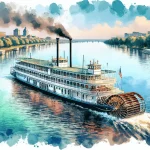New Orleans is famous for its Carnival celebrations, a tradition deeply rooted in the city’s history and culture. As the Carnival season commences, the streets burst into life with vibrant parades, elaborate costumes, and the infectious rhythms of jazz music. For first-time attendees, the experience can be both thrilling and overwhelming. However, with a bit of knowledge about the customs and traditions, anyone can immerse themselves in the enchantment of Carnival in New Orleans.
In This Article
TL;DR
- Carnival in New Orleans traces its origins to European pre-Lenten celebrations brought by French and Spanish settlers in the late 17th and early 18th centuries.
- The season begins with traditions like cutting the King Cake, the first krewe parades, and the appearance of iconic symbols such as masks, beads, and the colors purple, green, and gold.
- First-timers should plan ahead, arrive early for parades, wear comfortable shoes, be prepared for large crowds and unpredictable weather, and embrace the festive spirit by engaging with locals.
Historical Context of Carnival in New Orleans
The beginnings of Carnival in New Orleans can be traced back to the city’s early French and Spanish colonial period. In 1699, French-Canadian explorer Pierre Le Moyne d’Iberville and his crew landed near present-day New Orleans on Mardi Gras, naming the location “Point du Mardi Gras.” As more European settlers arrived, they brought with them the tradition of celebrating the period before Lent with masked balls, lavish feasts, and street parties.
Over time, these celebrations evolved to include parades and the formation of Mardi Gras krewes, which are social organizations responsible for planning and executing various Carnival events. The first recorded Mardi Gras parade in New Orleans took place in 1837, and by the late 19th century, the celebration had grown to include elaborate floats, costumes, and throws, such as beads and coins.
Significance of the Date and Season
Carnival season in New Orleans officially begins on January 6th, also known as Twelfth Night or Epiphany. This date marks the end of the Christmas season and the start of the pre-Lenten festivities. The duration of Carnival varies from year to year, depending on the date of Easter, but it always concludes on Mardi Gras, or Fat Tuesday, the day before Ash Wednesday.
The alignment of Carnival with the Christian calendar is significant, as it represents a period of indulgence and celebration before the solemn and reflective season of Lent. For many New Orleanians, Carnival is a time to let loose, connect with friends and family, and revel in the city’s unique cultural heritage.
Key Traditions at the Start of Carnival
One of the most beloved traditions at the start of Carnival is the King Cake. This sweet, circular pastry is decorated in the colors of Mardi Gras—purple, green, and gold—and often contains a small plastic baby figurine inside. The person who finds the figurine in their slice of cake is responsible for hosting the next King Cake party or purchasing the next cake, ensuring that the celebration continues throughout the season.
Another important tradition is the first parades of the Carnival season, which are typically smaller and more localized than the grand parades closer to Mardi Gras. These early parades, such as those put on by the Phunny Phorty Phellows and the Krewe of Joan of Arc, set the tone for the upcoming celebrations and give locals a taste of what’s to come.
Symbols and Iconography
The beginning of Carnival in New Orleans is marked by the appearance of several iconic symbols and images. Masks, which have been a part of Carnival celebrations since the early days, represent the spirit of mystery and anonymity that characterizes the season. Beads, thrown from parade floats, are cherished souvenirs and have become synonymous with Mardi Gras.
The colors of Mardi Gras—purple, green, and gold—also hold special significance. Purple represents justice, green represents faith, and gold represents power. These colors adorn everything from costumes and floats to decorations and King Cakes, creating a visually stunning display throughout the city.
Practical Tips for Attendees
For those attending Carnival in New Orleans for the first time, there are several best practices to keep in mind:
- Plan ahead: Book accommodations and transportation well in advance, as the city becomes increasingly crowded as Mardi Gras approaches.
- Arrive early for parades: Popular viewing spots along the parade routes fill up quickly, so arrive early to secure a good spot.
- Wear comfortable shoes: Carnival involves a lot of walking and standing, so wear comfortable, closed-toe shoes to avoid injury and fatigue.
- Be prepared for crowds: Carnival attracts millions of visitors to New Orleans, so be prepared for large crowds and potential delays in transportation and service.
- Stay safe: Stick with your group, keep valuables secure, and be aware of your surroundings at all times.
Cultural Impact and Community Involvement
The beginning of Carnival is not only a time of celebration for locals and visitors but also a significant economic driver for the city. Local businesses, from hotels and restaurants to costume shops and souvenir stores, experience a surge in sales during the Carnival season. Many New Orleanians also participate in the festivities by joining Mardi Gras krewes, volunteering at parades, or hosting parties and events.
The sense of community and shared cultural heritage that Carnival fosters is one of the reasons why the celebration remains such an integral part of New Orleans life. Generations of families have passed down Carnival traditions, ensuring that the spirit of the season continues to thrive year after year.
Comparison with Other Global Carnival Celebrations
While Carnival in New Orleans shares some similarities with other famous Carnival celebrations, such as those in Rio de Janeiro and Venice, it also has its own distinct flavor and traditions. New Orleans’ Carnival places a greater emphasis on parades and street celebrations, whereas Rio’s Carnival is known for its elaborate samba performances and Venice’s Carnival is famous for its ornate masks and balls.
Despite these differences, all three Carnival celebrations share a common spirit of joy, creativity, and community. The influence of New Orleans’ Carnival can be seen in other festivals worldwide, such as the Notting Hill Carnival in London and the Caribbean Carnival in Toronto, which have adopted elements of New Orleans’ music, dance, and costume traditions.
The beginning of Carnival in New Orleans marks the start of a beloved and time-honored tradition that showcases the city’s vibrant culture and history. By understanding the key traditions, symbols, and customs associated with the season, first-time attendees can fully immerse themselves in the magic of Carnival and create unforgettable memories. Whether you’re a local or a visitor, the beginning of Carnival in New Orleans is an invitation to let loose, celebrate life, and embrace the city’s joyous spirit!






